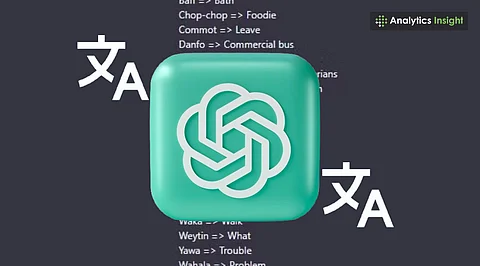

ChatGPT provides high-accuracy translations, thus facilitating quick and high-volume communication.
ChatGPT uses GPT-4o for translation purposes, enabling multiple-language translation at a very high degree of precision.
Using ChatGPT for translation, moreover, means enhancing productivity, widening accessibility, and extending the global reach of one's content.
ChatGPT has become a leading AI tool for translations thanks to its advanced GPT-4o model. Unlike other translation tools, ChatGPT utilizes cultural nuance and intent, resulting in far more natural and professional translations. ChatGPT represents an opportunity for businesses, content creators, and students to connect with others globally and communicate across multiple languages.
Translation is not as simple as taking a word and converting it to another language anymore. It is about ensuring that the meaning is conveyed in the right tone and style for the content to be understood by a global audience.
ChatGPT provides users with the option for quick, good translations and improves the language to make the message clear and engaging. Once you develop a transparent workflow, you can get faster and more reliable translations.
The first step is to choose an appropriate model to use for ChatGPT translations. GPT-4o provides the translations with great accuracy and can interpret complex sentences, idioms, and context, while GPT-3.5 can handle simpler translations.
Before carrying out any translations, users should ensure that they establish:
Source and target languages.
Purpose of the text (formal, casual, marketing, or technical).
Make sure the preferences match the audience's choice.
Any industry-specific jargon or keywords.
Giving clear instructions ensures the AI grasps subtle nuances and avoids mistranslations. Formality is needed in translating a legal document, whereas a casual tone would be appropriate for social media captions. To sound natural and professional, preparation is a must.
There are a few key steps to using ChatGPT effectively. The user enters a translation text with an exact prompt into the language pair and specified tone. The AI then produces a translated text that can be checked and corrected for grammar, style, and meaning.
For very long translations or if the meaning is very complex, reverse translation can confirm the meaning by translating the text back into the original language, along with post-editing to unify the texts and polish them.
Other outstanding features include:
Multimodal translations: Translate text from images or audio files into various languages.
Specify the domain: Legal, medical, and marketing terminology in their respective fields.
Tone variations: Lower creativity for exact, formal translations; higher for expressive, free writing.
The translations remain correct and engaging while catering to the people to whom they are explained.
Even though ChatGPT is a remarkable tool, it has multiple shortcomings. Local languages, as well as slang or idioms, could spell challenges for such systems; hence, there should be human oversight. Using a more widely used language like English as an intermediary helps with accuracy in more uncommon language pairs.
Never rely on automatic means to translate what matters, e.g., contract text or medical instructions; there has to be a professional who checks everything.
Some best practices include:
Using clear and precise prompts.
Keeping a glossary of terms for consistency.
Reviewing AI-generated content for appropriate cultural and contextual use.
Combining AI output with human proofreading if necessary.
This way, translations are guaranteed to be reliable, culturally appropriate, and professional.
ChatGPT is a modern translation solution owing to the fact that it navigates speed, accuracy, and contextual understanding. The professional model, GPT-4o, enables professionals to communicate across languages without sacrificing tone or message. ChatGPT includes multimodal translation, domain-specific prompts, and tone changes, which make it applicable to business, content creation, education, and research.
If ChatGPT is used as a translation tool in 2025, workflows will gain speed, along with consistency and global accessibility. By giving clear instructions and carefully reviewing the outputs, end-users will be able to get translations up to par with professional human translators. With further evolution in the AI field, ChatGPT will soon take over the translation arena, making multilingual communications easier than ever before.
Essential Tips for Efficient Translations:
Batch multiple paragraphs for consistent style.
Maintain a glossary for recurring phrases.
Adjust creativity levels depending on context.
Review outputs to ensure accuracy, especially for formal content.
1. Can GPT do language translation?
Yes, as with GPT-4o, the GPT models provide translation between languages. They consider context, grammar, and nuances to perform translations apt enough for casual conversation and professional material.
2. Can ChatGPT do document translation?
ChatGPT can translate documents in the manner of copying the document's text or sections of it into the chat for translation. Large files may have to be put in pieces, keeping the context so that the translation will be precise throughout the document.
3. Is ChatGPT a better translation than Google Translate?
Translations provided by ChatGPT usually have a better realization of intentions than Google Translate. Thus, ChatGPT takes into account the construction of sentences, tone, and meaning to provide more human-like translations rather than literal ones, which makes it perhaps more suitable for content with nuance.
4. Is ChatGPT translation free?
Users can translate text freely with ChatGPT translation through the regular ChatGPT interface without needing any subscription. However, the paid plan unlocks advanced features such as GPT-4o access and handling of extended text.
5. ChatGPT 4.0 Translator
ChatGPT 4.0 improves translation quality using dictionary definitions and idioms of all languages in regard to idioms. It is a multilingual translation tool and provides translations that are more precise, coherent, and natural as compared to earlier versions.
